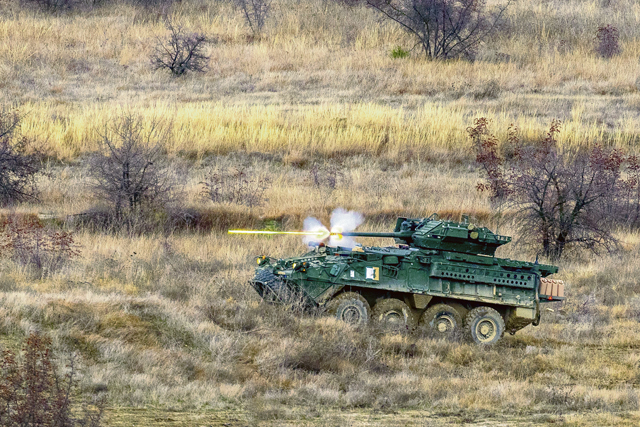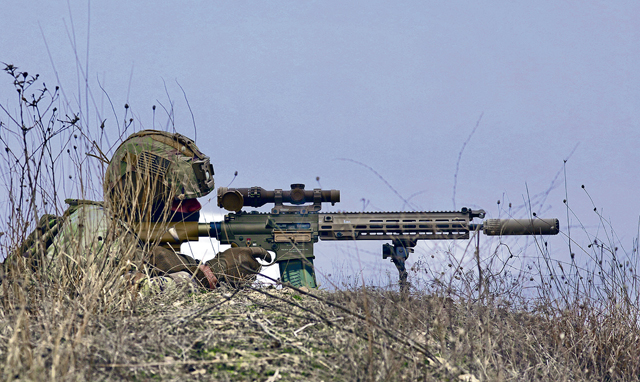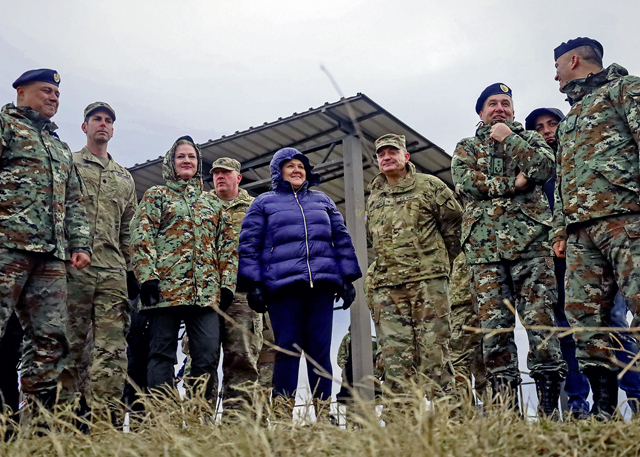
Soldiers from 2nd Cavalry Regiment, with support from other U.S. units and the host nation’s military, achieved rapid deployment to the training area and conducted live-fire scenarios with Stryker armored vehicles Dec. 1-10, at Krivolak Training Area, North Macedonia.
The Army of the Republic of North Macedonia hosted Brave Partner, while U.S. Army Europe and Africa led the “short notice action planning” exercise to reinforce military readiness and interoperability in a realistic training environment and to ensure U.S. forces are ready to respond quickly to support stability in the Balkans.
“The most important thing is the demonstration of the relationship between the United States and North Macedonia,” said Angela Aggeler, U.S. Ambassador to North Macedonia. “Exercises like this one, bringing in beautiful equipment like this — state of the art — really demonstrates to both of our countries, and frankly to the world and our NATO allies, how strong this relationship is, and we are there to support each other.”

The ambassador visited KTA, meeting with the Minister of Defense of the Republic of North Macedonia, Slavjanka Petrovska, and general officers from both nations’ armies to observe Brave Partner live-fire training on Dec. 7.
However, before live-fire training could take place, 2nd Squadron had to successfully complete expeditionary deployment training. Maj. Luke King, the 2nd Squadron, 2nd Cavalry Regiment operations officer, explained how important it was to exercise the processes of getting the soldiers and equipment to the mission, and then to set the conditions for day and night squad live-fire.
“Exercising those systems and validating those processes to make sure that we can deliver combat-ready troops to the training area, or to whatever mission we have, that was the first part,” said King. “They’ve gone through squad blank iterations and then squad live-fire iterations both day and night. And the goodness there is that it gives soldiers confidence in their weapons systems.”

He explained that the exercise gave company and squad leaders the ability to synchronize fire and maneuver with all their available weapons systems. He then explained the Stryker’s advantages, to include weapons systems that can be mounted to the vehicle.
The Stryker has several configurations, including an infantry carrier vehicle with a mounted remotely controlled weapons station capable of mounting a .50 caliber machine gun or a MK19 grenade launcher. They can fire 120 mm mortars from the back of the vehicle instead of setting up mortars from the ground, which King explained is a unique and awesome capability. Soldiers can fire those weapons and search and traverse from inside the vehicle with a screen that provides imagery.
“Then, the Dragoon has the 30 mm cannon, which we all love, and then a 7.62 coax as well, so you’re not just limited to that one weapons system,” said King. “Also, all fired from inside the vehicle, protecting the gunner.”

In addition to weapons used with the Strykers, each squad had a variety of weapons they fired while dismounted from their vehicles, including the M240 machine gun and the M249 Squad Automatic Weapon. They used their designated marksman to provide precision fire from a distance with the M110 A1 rifle, and they provided indirect fire with the M320 grenade launchers.
King said that 2CR gained in readiness and lethality due to Brave Partner. They’d conducted expeditionary deployments two previous times within the last several months, so they were confident and quick moving into North Macedonia.
I can’t emphasize enough how awesome of a training area Krivolak is,” said King. “It was just powerful to feel the full might of every headquarters at echelons above us all the way up to USAREUR-AF align the stars for us to get here so quickly. Whatever we asked for, we got. And we got it in a very rapid fashion, and it’s exactly what we wanted. So, it built a lot of our confidence.”
Sgt. Joshua Briggs, a 2CR infantryman and squad leader, adamantly agreed with King’s praise of KTA and the diverse terrain.
“The terrain out here is very difficult to traverse,” said Briggs. “It’s hilly and rocky. It allows for more intense and realistic training, like where these soldiers might operate in the future.”
Briggs said wet and muddy conditions give soldiers a chance to train while it’s more difficult to keep steady footing, or to avoid the weapons’ exposure to the elements. The training value is higher because they can still effectively prepare and solve objectives in such conditions, simulating actual combat.
Another 2CR soldier, Pfc. Alexander Dudzenski, said Brave Partner was his first live-fire exercise. He enjoyed training despite the harsh environment and weather, learning something new with every range iteration and seeing the host nation soldiers build a working relationship with U.S. soldiers.
“I never thought in my life that I’d be able to come and see these countries,” said Dudzenski. “I think it’s cooler to do it somewhere I’ve never been before, and seeing people from different militaries watching us, I find fascinating.”
Briggs agreed, saying it’s always a privilege to work with NATO partners, especially when it’s the first time for him in a country, where his squad can share new ideas to refine and improve their craft.
“Host nation soldiers have been extremely polite and helpful,” Briggs said. “They’ll ask us questions. It allows us to explain our profession as well as our craft and take pride in our work and see how other people see it.”
King agreed that 2CR learned much from working with the host nation.
“The Army of the Republic of North Macedonia has been very accommodating,” said King. “Understanding how they conduct training and telling them how we conduct our own training in preparation for their army to receive their Strykers has been very useful because we also learn from them. Some of the questions they ask force us to be a bit more introspective. We’re not only helping them, but we’re helping ourselves too.”


